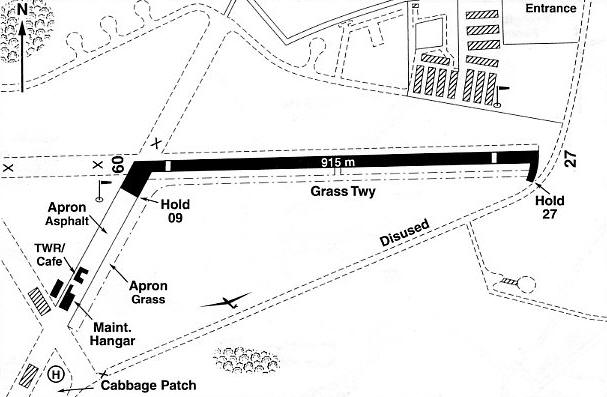Turweston
TURWESTON: Military aerodrome later gliding site then civil aerodrome
(Listed as being in BUCKINGHAMSHIRE in WW2)
Note: This picture (2017) was obtained from Google Earth ©
The extent of the WW2 airfield and the three runways can still be clearly seen. The E/W runway, still used today, was roughly a third longer in WW2.
Military user: RAF Bomber Command 92 Group
12 OTU [Operational Training Unit] (Avro Ansons & Vickers Wellingtons)
13 OTU (North American B-25 Mitchells)
17 OTU {Gunnery Flight] (Miles Martinets & Vickers Wellingtons)
307 FTU [Ferry Training Unit] (Douglas DB-7 Bostons)
Note: Other types seen at TURWESTON during WW2 were: Airspeed Oxfords, DH Mosqitos, Hawker Hurricanes & Westland Lysanders. And probably many more.
Operated by: 1970s & 1980s: Brackley Gliding Club
2000: Turweston Flight Centre Ltd
Flying club/school: Post 1945: Turweston Aero Club & Flying School
Maintenance: 2000: AKKI Aviation Services Ltd
Location: 9nm E of Aylesbury accordingly to the 'Bible' of WW2 airfields by Steve Willis and Barry Hollis ‘Military Airfields’ in which they say they relied of ‘official records’ and which I have used as a major source of reference. It really is invaluable.
But, the information must always be read with a heavy degree of sceptiscm regarding accuracy, especially as to where some aerodromes are located. There are just a few glaring errors and this aerodrome is a good example.
TURWESTON is actually 2nm ENE of Brackley about 19nm NORTH WEST of Aylesbury! How can anybody get this sort of very basic information so totally wrong? One reason is probably because they did not spend over forty years driving, and over twenty five years flying around the UK. Which, I like to think, expands situational awareness - like; where places are.
I’ll bet I have made some mistakes in this 'Guide' - but hopefully not such a blunder as this!
Period of operation: Military: 1942 to 1945 Civil: GA from 1994 to present day
Note: Thess maps are reproduced with the kind permission of Pooleys Flight Equipment Ltd. Copyright Robert Pooley 2014.
Runways: WW2: 10/28 1829x46 hard 04/22 1280x46 hard
16/34 1006x46 hard
2000: 09/27 915x18 hard
NOTES: The Popular Flying Association HQ was moved here, after at least five decades based at Shoreham in Sussex, opening on the 1st December 2003. In late 2009 the PFA changed its name to the LAA (Light Aircraft Association). It might wll be impossible to describe the immense influence the PFA/LAA has had on light aviation since its inception at ELSTREE as the ULAA in 1946 with just a few dedicated members fighting the system - and eventually succeeding.
It really has been an astonishing success, despite often painful periods - usually short lived. And, without any doubt, arguably the major contributor in the UK to enabling a huge variety of classic light aircraft to keep flying.
Plus of course, the more obvious achievement; to enable many hundreds of people each year, (now numbering thousands in total), to build their own aircraft - and fly them.
This aerodrome has had an endless series of unusual and unique visits by aircraft whose owners are prepared to lend their very valuable and treasured possessions for an air test to be conducted by Francis Donaldson of the LAA, and then to be featured in Light Aviation magazine. Something that has delighted so many of us.
THE VIMY MAKES A VISIT
In the 2005 the Vickers Vimy made a visit, surely the largest ‘homebuilt’ aircraft to fly and perhaps the biggest aircraft to visit since WW2? It then went on to visit OLD WARDEN, GOODWOOD and WOOBURN ABBEY. See SHOREHAM (SUSSEX) for a couple of pictures. For younger visitors to this 'Guide' who might be unaware of the Vickers Vimy claim to fame. It was the first aircraft to achieve a crossing of the Altantic Ocean in June 1919 crewed by John Alcock and Arthur Brown. After leaving St John's in Newfoundland, they landed in a bog near Clifden in County Galway in Ireland. Which, in those days, was still part of the United Kingdom.
A PERSONAL MEMORY
In May 1995, Guy Browning and I, with two passengers who had never flown in a light aircraft before, had planned a trip to south Wales. However, landing at WELLESBOURNE MOUNTFORD on the way out, and appraising the latest weather forecasts which showed that a front of stormy weather was moving in from the Atlantic faster than expected, we called in to SHOBDEN for a night stop, before returning east the next day, back to TOP FARM.
During the night the incoming front appeared to have pretty much stopped in its tracks, but as the day progressed it was clearly on the move again. The following morning was glorious, fresh and clear, and we also landed at STAVERTON. Looking at the chart for a new place to visit, TURWESTON seemed appealing, but, as can be seen in the first picture, our visit was quite brief as the incoming front was now catching up.
ANOTHER PERSONAL MEMORY
In June 2008 I was given the job of moving the Vans RV10 (G-RVIO) from Caversham to TURWESTON. This was a very significant aeroplane in several respects. Built by Roger Hopkinson who is of course a major figure in the Light Aviation Association, this was the first four-seater design by Vans. And, this was not only the first RV10 to be built in the UK, it was also the first to fly in Europe.
It was always a privilege to move any aeroplane, and, as in this case, doubly so when tasked with moving an aircraft with historical significance.
We'd love to hear from you, so please scroll down to leave a comment!
Leave a comment ...
Copyright (c) UK Airfield Guide





















